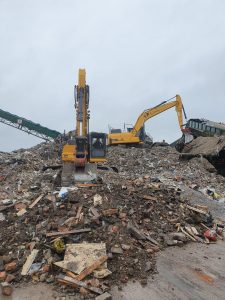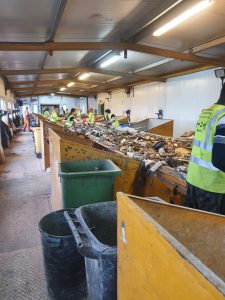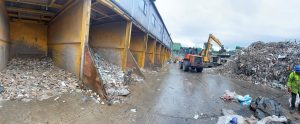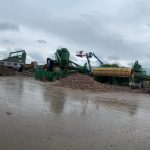Within the 15,000 tonnes of waste that we process each month, we receive a wide range of materials. Therefore, it is imperative that all waste is separated into the correct streams and dealt with in the appropriate manner. In order to do this, we use numerous methods of material separation as waste passes through the mechanical plant.
Certain items must be removed immediately from the tipped load. These include non-compliant items such as fire extinguishers and large pieces of aggregate (Brick, concrete and glass), metal and plastic. We do this because these items could damage our plant. The initial sort is done by plant operatives or by hand. Smaller pieces of waste, such as gas bottles, can be removed by our site staff, whereas large pieces of waste must be removed by one of our grab machines. All other mixed waste can then be transferred to the large processing pile at the rear of the tipping facility.

Once in the processing pile, our fuel-efficient excavators move the waste onto a conveyor belt, where it can begin its journey through our plant.
The next type of separation we use is size separation. Our trommel allows us to separate all of our waste based on its size. If material is smaller than 50mm, it is sent to our fines treatment area. All material larger than 50mm then continues through the mechanical plant.

Ferrous metals can be removed from the general waste stream based on its magnetism, whereas bricks are separated based on their high density. Dense pieces of aggregate are transferred to an aggregate pile ready to be crushed. After aggregate has been removed, magnets will pick up all remaining ferrous metals that pass through the plant. The metal can be easily collected in various waste bays before being sent to scrap metal dealers for recycling.
Residual items are then transported by conveyor belt to one of our waste picking lines. This is where physical separation takes place. Employees on the picking line are looking out for any material that can be recycled. This often results in staff removing high quantities of wood as this is a common waste stream that regularly arrives at our facility in mixed waste skips. We have numerous bays below the picking line for separate types of waste, these include plastics, small aggregates, and plasterboard. After removing materials, the picking line staff place the items into the various bays.

Materials that are unable to be recycled are put through a Terrex Shredder and converted into Refuse Derived Fuel (RDF). RDF is an alternative fuel which can be burned to create heat and electricity in a waste to energy facility. Finding ways to recover waste that can’t be recycled is a key component of our business strategy. Energy recovery allows us to offer alternatives to non-renewable energy sources and operate in a sustainable way.
All of the separation techniques that we conduct at our facility gives us the ability to process over 15 000 tonnes of waste each month, with over 99% of the materials we receive being diverted from landfill.
Look out for our next blog in the series as we continue to explain our operations processes in detail.


